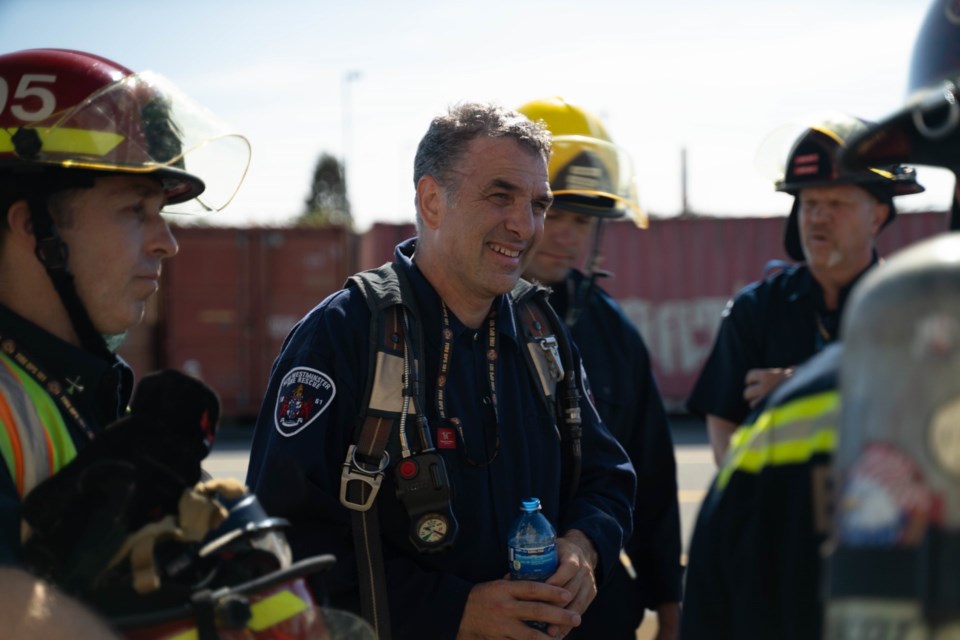It wasn’t a typical day at the office for Mayor Patrick Johnstone.
Instead of meetings at city hall, Johnstone took part in Fire Ops 101 on Monday – getting a glimpse into the work of a firefighter.
“It was humbling. It was sometimes terrifying. It was really educational,” he said. “It was it was a good experience.”
Fire Ops 101, held at the Vancouver Fire and Rescue Training Centre on Sept. 18, is a day-long program organized by the BC Professional Fire Fighters Association. It includes scenarios such as hands-on firefighting and rescue operations, all done under the supervision of the Vancouver Training Division personnel and BCPFFA representatives.
“Fire Ops 101 offers insight into the physical and psychological demands of the job,” said Todd Schierling, President of BC Professional Fire Fighters’ Association. “Participants will appreciate what firefighters on the frontlines are going through, and this experience helps them understand the challenges faced to keep our communities safe.”
Johnstone – as well a number of mayors, councillors and city managers from across B.C. – took part in this year’s event.
The BC Professional Fire Fighters Association said participants experience the realities of firefighting through several scenarios representing the dynamic occupation of a professional firefighter.
While Johnstone is familiar with the work of New Westminster Fire and Rescue Services through his role at city hall, he said the experience gave him a deeper understanding of the work of firefighters. One thing he didn’t expect?
“The chaos,” he said. “They put you in fire gear with a SCBA (self-contained breathing apparatus) tank on and they send you into a dark room and ask you to sort of follow these simple instructions. And you think you know what you're doing, and then you're in there, and it all goes away.”
Johnstone said that experience is extremely disorienting and makes you aware of how much training – and the importance of that training – to make sure firefighters know how to manage that chaos and to prioritize their own lives and the lives of the people around them.
“It's humbling to sort of go through that experience,” he said.
The BC Professional Fire Fighters Association said participants, suited up in training gear, including a self-contained breathing apparatus, would experience the physical exertion and the teamwork needed when entering and extinguishing a controlled building fire.
“They actually have to work together as an integrated team. There's no being by themselves in that building,” Johnstone said. “They can't be because things do turn into chaos, and they have to be able to rely on each other.”
The day’s activities were demanding, both physically and mentally.
“It was absolutely exhausting after five minutes of it,” Johnstone said. “You are working with a SCBA, you're working with an air regulator. And when you get in there, you have to carry all this gear up for storeys. You're always kind of in a bit of a panic.”
Johnstone was paired with a team of four local politicians, each who had a “handler” – a trained firefighter. A member of New Westminster Fire and Rescue Services was Johnstone’s trainer and ensured his safety throughout the day’s activities.
Fire Ops 101 also gave participants a chance to use specialized life-saving equipment, such as hydraulic cutters and spreaders.
“We got to play with the car destruction tools, which is always fun,” Johnstone said. “It’s to see how they actually take a car apart in order to extract people from the car, if there has been an accident.”
Through the program, Johnstone was reminded that the fire-retardant chemicals used on firefighters’ turnout gear is known to cause cancer. Despite the risk, he said firefighters have to put on their “fire blankets” before they go into fires.
“They're very aware that every time they put turnout gear on, that's what it means to them. Part of the reason why cancer rates in firefighters are so high is because of that occupational hazard that they're exposed to every day,” he said. “And, you know, that's an important reminder to be telling us as elected officials who are going to have to be asked at some point to replace that material with a non-cancerous material when that is invented. And it was important for us to know that this was going to be a cost you're going to be seeing.”
While Fire Ops 101 is useful for elected officials, Johnstone said the activities only provided a snapshot of the work of firefighters.
“We know that we're that we're sending people into dangers way in order to save people's lives and save property; we know we're doing that,” he said. “But I think maybe it makes it more relatable, easier to understand, by putting us through that. Again, recognizing that putting us through a simulation of what it's like, it’s not the real thing. It's a very big step between what we were doing and what the real thing is.”



